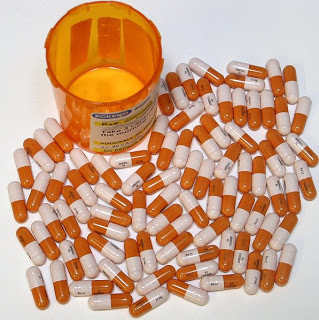During the Great Ritalin Scare of 1993, shortages prompted thousands to switch to Adderall. Now, Shire is contriving an Adderall drought to convert patients to a new ADD drug.
 |
| Adderall – Wiki Image |
Moe Tkacik
The Fix
When Jay V.’s pharmacist told him about the nationwide Adderall shortages last weekend, he reacted as any economically rational finance professional would, and attempted to bribe her. Whatever the cost, “it’s cheaper than cocaine,” his reasoning went. And even if it isn’t, you can’t put a price on never having to go back to doing bumps in the work bathroom to get through late night deal committee meetings, can you?
Jay’s pharmacist said she was reserving her supply for regular customers, but that the price had doubled and the clock was ticking. “They’re down to one bottle,” Jay said, “and if I don’t get them a prescription by the end of next week I forfeit my right to it.” So long as he can tear himself away from one of the 16-hour days he cites as the reason he needs Adderall to begin with, he’ll be fine. At least, for the next month or so…
If addiction is the kind of thing you think about a lot, it’s easy to overlook its significance in the cold, objective Realpolitik scheme of things, which is this: it’s a great fucking business model. From the British East India Company to the Bronfman clan to Duke University, history is redolent of abject mediocrities who owe their billions to Big Addiction.
 |
| Ad |
The best of the addiction-based business models are “addiction-proof” addictive drug, and the Adderall story is at its core the saga of a nearly century-long quest for this unattainable ideal. Amphetamine salt—Adderall’s active ingredient—has been the subject of heady dispute within the medical profession since the drug company Smith, Kline and French began peddling the stuff in 1935, but for decades just about the only thing medical community generally agreed about was that it was not addictive. The SKF sales department did, however, have a term for the loyalty it engendered among consumers: “stick.”
The dawn of the Drug War eventually in the early 1970s eventually brought an end to the widespread use of those first-generation amphetamines, but naturally they “stuck” around in some circles. And then in the nineties, when upper-middle class America was stricken with a modern epidemic of ADD (and its “hyperactive” variant ADHD) necessitating widespread amphetamine use while simultaneously the nation’s truck stops and trailer parks began falling prey to the scourge of illegal amphetamines—and yet no one ever seemed to link the two—it appeared as though an element of cognitive dissonance about the stuff had also “stuck.” For the same reason crystal meth never found much “stick” as an ADD drug—although it’s out there, under the brand name Desoxyn—Adderall users for the most part never identified as “addicts” before the nightmare shortages of this year.
You can map the spread of this rude (albeit unbearably drowsy) awakening on the message boards at ADDForums.com, whose administrators have painstakingly aggregated all Amphetamine Famine-relevant posts into a single “sticky” thread, starting with its early rumblings across flyover country in March, when the first unlucky ADD sufferers in pockets of Texas, Georgia and a few other states began to chronicle tales of the panicked multi-state manhunts and exorbitant ransoms to which they’d been subjected following the inevitable 15-minute pharmacy trip that wasn’t. The real panic set in around mid-August, when a supply shock attributed to “back-to-school” season ravaged the suburbs.
A guy in New Jersey who’d been paying $9 for his monthly prescription for years suddenly had to scour every pharmacy in a 50-mile radius and cough up $99. A woman in Massachusetts reported calling 25 pharmacies and only finding one that would fill her prescription—for $408; a man from Massachusetts advised her to take his advice offered to share the spreadsheet of eastern Massachusetts and New Hampshire drug stores he’d compiled a few days while making the rounds trying to figure out where to fill his own prescription. (He’d listed 142 by the time he found—at #48—his meds.) Finally this month came the first plaintive posts from New York, where a young woman who’d spent all day running to different drug stores wondered whether it was more dehumanizing to be gazed upon as some sort of “crack addict” by so many pharmacists, or just “feel[ing] like a junky” to begin with, and Los Angeles, where an electrician on his third day without meds wrote plaintively:
“Been taking adderall for over 13 years and now I can’t refill my script…What am I supposed to do? Just get over it? Just suck it up, go cold turkey and maybe I’ll get my script filled in a few months? How can I keep working on dangerous equipment with high voltage everywhere and I can’t focus? How can I commute 2 hours a day without falling asleep at the wheel? I feel so alone. Don’t know where to go at this point.”
linkwithin_text=’Related Articles:’


Be the first to comment on "Pay Attention: How Big Pharma Contrived the Great American Adderall Drought"